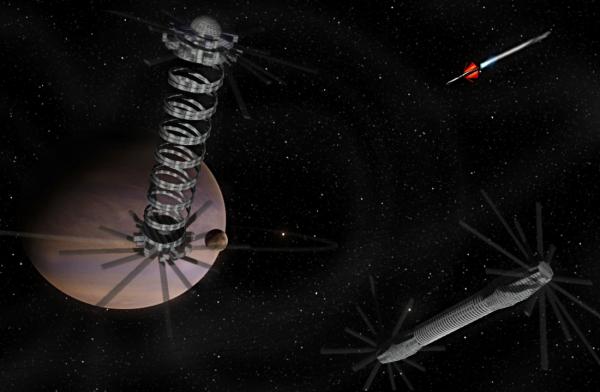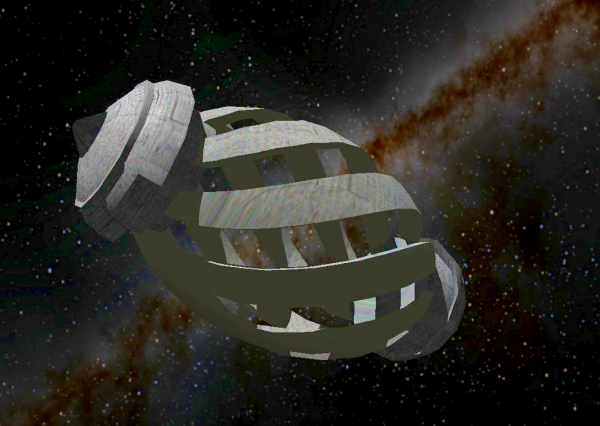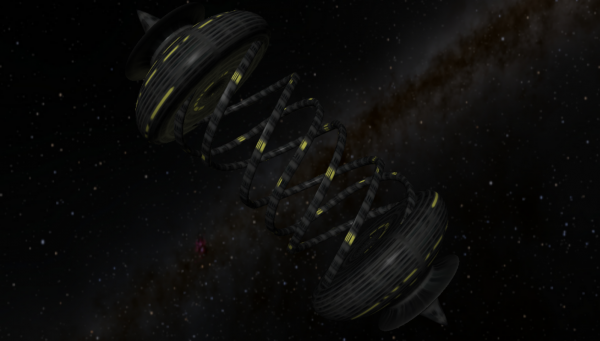BY LETTER
New Magnitogorsk
Galactography > Regions of Space > Middle Regions/Hinter-regions
Galactography > Sephirotic Empires > Mutual Progress Association
Galactography > Sephirotic Empires > Mutual Progress Association
System with highly magnetic gas giant | |
 Image from Steve Bowers | |
| The dynamo ring circling New Magnitogorsk generates power from the magnetic field of this giant world; this is beamed to the habitats and is used for life support. | |
Type K2V
RA 266.08333 Dec -19.1752777
Distance from Sol 2063ly
Gal xyz 2033.11, 292.82, 191.56
Colonised 6109 AT
World New Magnitogorsk
Type Rapidly rotating EuJovian gas giant with strong magnetic field
Diameter 151,090km
Oblateness 0.101
Many of the earliest colonists in this system were displaced from the Theta Persei system after the Version War. A gas giant in that system, Magnitogorsk, used an extensive dynamo ring to generate power, thus maintaining independence from the Theta Persei Dyson Swarm. When Bourgatov was attacked in 4482 and the Dyson Swarm was destroyed, hundreds of millions of refugees fled to Magnitogorsk, causing severe overcrowding.
New Magnitogorsk, a world orbiting JD 109771067 with an even stronger magnetic field than the planet it was named for, attracted many colonists from the Theta Persei system. Here they colonists set up the same dynamo system as used at Old Magnitogorsk; a ring of tethers and counterweights circle the planet at a height of 50,000km above the clouds, drawing energy from the magnetic field and the rotation of the gas giant itself. This power is beamed to numerous rotating habitats in orbit further out from the planet's surface to power life support systems including CELSS and recycling systems. The extracted energy is also used to power magshields to protect against the charged particles trapped in the magnetosphere surrounding this planet .
 Image from Steve Bowers | |
| Archangelsk Habitat, which has a deep sea in the widest, equatorial section of its spiral structure. | |
Spiral Habitat culture
There are around 30,000 habitats orbiting New Magnitogorsk in the Current Era. Many of these habitats are constructed in spiral form, an aesthetic and cultural choice which creates an unusual internal environment. The tubes forming these spirals are often a few tens of kilometres in radius, but are tightly wound into a helix several thousand kilometres long. This means the internal geography of such a spiral forms a long and relatively thin strip, and communication between the communities in the spiral occurs along a small number of long transport highways. Unless they leave the spiral's interior and travel though the external infrastructure, travellers must pass through (or past) each of these communities in turn.Most, but not all, spirals have a strong tradition of megastructure migration; usually this forms at least two streams of migration moving in opposite directions. Periodically a significant fraction of a community will leave their homes and migrate in one direction or another, encountering sophonts on their travels who are travelling in the opposite direction and who have news from further down the spiral.
Some travellers (the Fast Trackers) use the tracklines that run along network of cables that hold the spiral together; without these cables the spirals would unwind at the centre. Fast Trackers can move across the cables to the Hubline, then travel to the endcaps or to other destinations in the hab relatively quickly. Not every habitat has a public transport system associated with the cables, although rescue services can use the Hubline to gain access in emergencies.
 Image from Steve Bowers | |
| Vesna habitat, one of the oldest habs in this system. | |
Related Articles
Appears in Topics
Development Notes
Text by Steve Bowers
Initially published on 27 October 2016.
Initially published on 27 October 2016.






